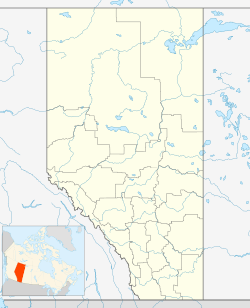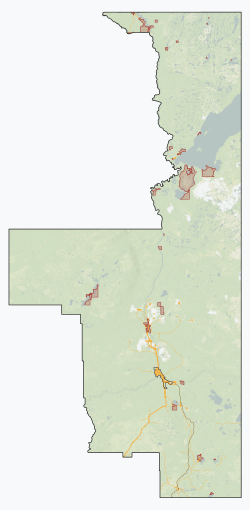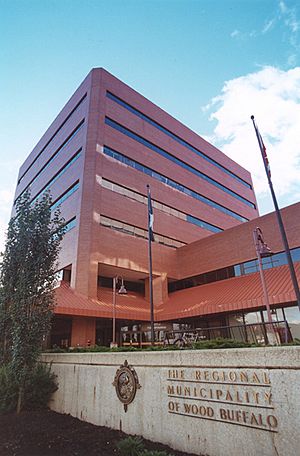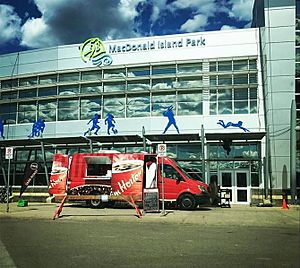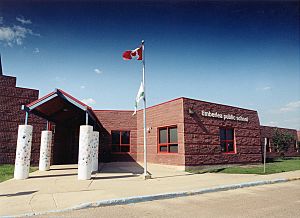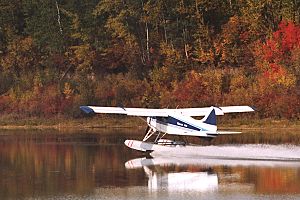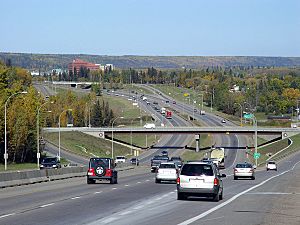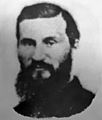Fort McMurray facts for kids
Quick facts for kids
Fort McMurray
McMurray (1947–1962)
|
|
|---|---|
| Fort McMurray Urban Service Area | |
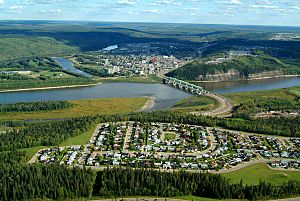
Aerial view of Fort McMurray with Athabasca River
|
|
| Nicknames:
"Fort Mac", "Fort McMoney"
|
|
| Motto(s):
We Have The Energy
|
|
| Country | Canada |
| Province | Alberta |
| Region | Northern Alberta |
| Census division | 16 |
| Specialized municipality | RM of Wood Buffalo |
| Founded | 1870 |
| Incorporated | |
| • Village | May 6, 1947 |
| • Town | December 29, 1948 |
| • New town | June 30, 1964 |
| • City | September 1, 1980 |
| Name changed | June 1, 1962 |
| Amalgamated | April 1, 1995 |
| Area
(2021)
|
|
| • Urban | 52.17 km2 (20.14 sq mi) |
| Elevation | 260 m (850 ft) |
| Population
(2021)
|
|
| • Urban | 68,002 |
| • Municipal census (2018) | 72,056 |
| See Demographics section for population counts from RM of Wood Buffalo's recent municipal censuses. | |
| Demonym(s) | McMurrians, McMurrayites |
| Time zone | UTC−07:00 (MST) |
| • Summer (DST) | UTC−06:00 (MDT) |
| Forward sortation areas |
T9H - T9K
|
| Area code(s) | 780, 587, 825, 368 |
| Highways | 63, 69 |
| Waterways | Athabasca River, Clearwater River, Hangingstone River, Horse River |
| Website | RM of Wood Buffalo |
Fort McMurray ( mik-MURR-ee) is an urban service area in the Regional Municipality (RM) of Wood Buffalo in Alberta, Canada. It is located in northeast Alberta, in the middle of the Athabasca oil sands, surrounded by boreal forest. It has played a significant role in the development of the national petroleum industry. The 2016 Fort McMurray wildfire led to the evacuation of its residents and caused widespread damage.
Formerly a city, Fort McMurray became an urban service area when it amalgamated with Improvement District No. 143 on April 1, 1995, to create the Municipality of Wood Buffalo (renamed the RM of Wood Buffalo on August 14, 1996). Despite its current official designation of urban service area, many locals, politicians and the media still refer to Fort McMurray as a city. Fort McMurray was known simply as McMurray between 1947 and 1962.
Contents
History
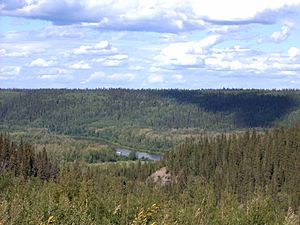
Before the arrival of Europeans in the late 18th Century, the Cree were the dominant First Nations people in the Fort McMurray area. The Athabasca oil sands were known to the locals and the surface deposits were used to waterproof their canoes. In fur trade days the location of Fort McMurray was an important junction on the fur trade route from eastern Canada to the Athabasca country. In 1778, the first European explorer, Peter Pond, came to the region in search of furs, as the European demand for this commodity at the time was strong. Pond explored the region farther south along the Athabasca River and the Clearwater River, but chose to set up a trading post much farther north by the Athabasca River near Lake Athabasca. However, his post closed in 1788 in favour of Fort Chipewyan, now the oldest continuous settlement in Alberta.
In 1790, the explorer Alexander MacKenzie made the first recorded description of the oil sands. By that time, trading between the explorers and the Cree was already occurring at the confluence of the Clearwater and Athabasca Rivers. The Hudson's Bay Company and the North West Company were in fierce competition in this region. Fort McMurray was established there as a Hudson's Bay Company post by 1870, named for Factor William McMurray. It continued to operate as a transportation stopover in the decades afterwards. The Alberta and Great Waterways Railway arrived in 1915 complementing existing steamboat service.
The community has played a significant role in the history of the petroleum industry in Canada. Oil exploration is known to have occurred in the early 20th century, but Fort McMurray's population remained small, no more than a few hundred people. By 1921, there was serious interest in developing a refining plant to separate the oil from the sands. Alcan Oil Company was the first outfit to begin bulk tests at Fort McMurray. The nearby community of Waterways was established to provide a terminus for waterborne transportation, until 1925, when the Alberta and Great Waterways Railway reached there.
Abasands Oil was the first company to successfully extract oil from the oil sands through hot water extraction by the 1930s, but production was very low. Fort McMurray's processing output gradually grew to over 1,100 barrels/day by World War II, and Fort McMurray was set up by the US and Canadian forces as staging ground for the Canol project.
Fort McMurray and Waterways amalgamated as the village of McMurray (the "Fort" was dropped until 1962, when it was restored to reflect its heritage) by 1947, and became a town a year later. Fort McMurray was granted the status of new town so it could get more provincial funding. By 1966, the town's population was over 2,000.
In 1967, the Great Canadian Oil Sands (now Suncor) plant opened and Fort McMurray's growth soon took off. More oil sands plants were opened up, especially after 1973 and 1979, when serious political tensions and conflicts in the Middle East triggered oil price spikes. The population of the town reached 6,847 by 1971 and climbed to 31,000 by 1981, a year after its incorporation as a city.
The city continued to grow for a few years even after the oil bust caused by the collapse in world oil prices. The population peaked at almost 37,000 in 1985, then declined to under 34,000 by 1989. Low oil prices since the oil price collapse in 1986 slowed the oil sands production greatly, as oil extraction from the oil sands is a very expensive process and lower world prices made this uneconomical. Oil price increases since 2003 made oil extraction profitable again for around a decade, until another slump in oil prices which began in December 2014 and deepened in 2015 resulted in layoffs and postponement of projects.
On April 1, 1995, the City of Fort McMurray and Improvement District No. 143 were amalgamated to form the Municipality of Wood Buffalo. The new municipality was subsequently renamed the Regional Municipality (RM) of Wood Buffalo on August 14, 1996. As a result, Fort McMurray was no longer officially designated a city. Instead, it was designated an urban service area within a specialized municipality. The amalgamation resulted in the entire RM of Wood Buffalo being under a single government. Its municipal office is located in Fort McMurray.
May 2016 wildfire
On May 3, 2016, at 5:00 pm MDT a large wildfire burning southwest of Fort McMurray resulted in the mandatory evacuation of 12 communities in the city's area. Later that evening, all of Fort McMurray was placed under a mandatory evacuation. Record-breaking temperatures, reaching 32.8 °C (91 °F), low relative humidity and strong winds contributed to the fire's rapid growth in forests affected by "an unusually dry and warm winter".
More than 100,000 residents of the city and surrounding region were evacuated. This was the largest recorded wildfire evacuation in Canadian history and the third-largest recorded environmental disaster evacuation.
About one-fifth of homes in the city were reported to be destroyed in the fire.
Geography
Fort McMurray is 435 kilometres (270 mi) northeast of Edmonton on Highway 63, about 60 kilometres (37 mi) west of the Saskatchewan border, nestled in the boreal forest at the confluence of the Athabasca River, the Clearwater River, the Hangingstone River, and the Horse River. It sits at 370 metres (1,210 ft) above sea level. Fort McMurray is the largest community in the Regional Municipality of Wood Buffalo.
White spruce, trembling aspen, balsam poplar and white birch are the most prominent native trees in and around town. Black spruce and tamarack occur in poorly drained areas and jack pine may be seen on the driest sites. European aspen, blue spruce and sand cherry are among the exotic trees occasionally seen.
Climate
With severe winters except during periods of warming chinook winds, mild to warm summers and only three months whose average temperature is higher than 10 °C (50 °F), Fort McMurray has a borderline subarctic climate (Köppen climate classification Dfc), very slightly below to be considered a humid continental climate as May averages 9.9 °C (49.8 °F); and falls into the NRC Plant Hardiness Zone 3a.
The community lies at a lower elevation than most other parts of Alberta, so under the right conditions it can be a “hot spot” for Alberta, or even all of Canada (as in April 1980 when its daily mean temperature of 10 °C (50 °F) was unsurpassed by any other Canadian station).
Temperatures range from an average of −17.4 °C (0.7 °F) in January, to 17.1 °C (62.8 °F) in July. The average annual precipitation is 418.6 millimetres (16.48 in) and falls mainly in the summer months. Average annual snowfall is 133.8 centimetres (52.7 in), most of which falls between October and April.
The highest temperature ever recorded in Fort McMurray was 38.9 °C (102 °F) on July 18, 1941. The lowest temperature ever recorded was −53.3 °C (−64 °F) on February 1, 1917 and December 31, 1933.
| Climate data for Fort McMurray Airport, 1981−2010 normals, extremes 1908−present | |||||||||||||
|---|---|---|---|---|---|---|---|---|---|---|---|---|---|
| Month | Jan | Feb | Mar | Apr | May | Jun | Jul | Aug | Sep | Oct | Nov | Dec | Year |
| Record high humidex | 14.6 | 13.4 | 19.8 | 30.4 | 35.6 | 38.3 | 45.6 | 40.5 | 33.7 | 28.4 | 15.5 | 10.4 | 45.6 |
| Record high °C (°F) | 15.1 (59.2) |
16.1 (61.0) |
20.1 (68.2) |
35.0 (95.0) |
36.7 (98.1) |
36.8 (98.2) |
38.9 (102.0) |
37.0 (98.6) |
32.4 (90.3) |
29.4 (84.9) |
18.9 (66.0) |
10.7 (51.3) |
38.9 (102.0) |
| Average high °C (°F) | −12.2 (10.0) |
−7.1 (19.2) |
0.6 (33.1) |
10.0 (50.0) |
16.9 (62.4) |
21.5 (70.7) |
23.7 (74.7) |
22.2 (72.0) |
15.8 (60.4) |
7.4 (45.3) |
−4.3 (24.3) |
−10.1 (13.8) |
7.0 (44.6) |
| Daily mean °C (°F) | −17.4 (0.7) |
−13.3 (8.1) |
−6.2 (20.8) |
3.3 (37.9) |
9.9 (49.8) |
14.6 (58.3) |
17.1 (62.8) |
15.4 (59.7) |
9.5 (49.1) |
2.3 (36.1) |
−8.6 (16.5) |
−15.1 (4.8) |
1.0 (33.8) |
| Average low °C (°F) | −22.5 (−8.5) |
−19.5 (−3.1) |
−12.9 (8.8) |
−3.5 (25.7) |
2.8 (37.0) |
7.7 (45.9) |
10.5 (50.9) |
8.6 (47.5) |
3.2 (37.8) |
−2.8 (27.0) |
−12.9 (8.8) |
−20.0 (−4.0) |
−5.1 (22.8) |
| Record low °C (°F) | −51.7 (−61.1) |
−53.3 (−63.9) |
−44.4 (−47.9) |
−34.4 (−29.9) |
−17.3 (0.9) |
−6.1 (21.0) |
−3.3 (26.1) |
−6.1 (21.0) |
−15.6 (3.9) |
−24.5 (−12.1) |
−41.7 (−43.1) |
−53.3 (−63.9) |
−53.3 (−63.9) |
| Record low wind chill | −58.4 | −59.6 | −56.8 | −45.8 | −21.0 | −6.3 | 0.0 | −6.1 | −16.0 | −31.7 | −50.1 | −53.2 | −59.6 |
| Average precipitation mm (inches) | 17.7 (0.70) |
13.2 (0.52) |
16.7 (0.66) |
21.4 (0.84) |
36.5 (1.44) |
73.3 (2.89) |
80.7 (3.18) |
57.1 (2.25) |
39.7 (1.56) |
26.2 (1.03) |
19.9 (0.78) |
16.4 (0.65) |
418.6 (16.48) |
| Average rainfall mm (inches) | 0.4 (0.02) |
0.7 (0.03) |
2.1 (0.08) |
11.0 (0.43) |
33.5 (1.32) |
73.3 (2.89) |
80.7 (3.18) |
57.1 (2.25) |
38.8 (1.53) |
15.6 (0.61) |
2.6 (0.10) |
0.7 (0.03) |
316.3 (12.45) |
| Average snowfall cm (inches) | 23.8 (9.4) |
18.4 (7.2) |
19.1 (7.5) |
11.9 (4.7) |
3.5 (1.4) |
0.0 (0.0) |
0.0 (0.0) |
0.0 (0.0) |
0.9 (0.4) |
12.2 (4.8) |
22.9 (9.0) |
21.3 (8.4) |
133.8 (52.7) |
| Average precipitation days (≥ 0.2 mm) | 12.3 | 10.4 | 9.6 | 8.5 | 11.3 | 14.2 | 15.8 | 13.2 | 12.5 | 10.9 | 12.0 | 11.8 | 142.5 |
| Average rainy days (≥ 0.2 mm) | 0.63 | 0.59 | 1.5 | 5.7 | 10.6 | 14.2 | 15.8 | 13.2 | 12.3 | 6.7 | 1.9 | 0.68 | 83.7 |
| Average snowy days (≥ 0.2 cm) | 13.2 | 11.1 | 9.4 | 4.1 | 1.4 | 0.0 | 0.0 | 0.04 | 0.52 | 5.9 | 11.9 | 12.4 | 69.9 |
| Mean monthly sunshine hours | 77.7 | 113.8 | 176.0 | 217.3 | 276.5 | 264.5 | 285.5 | 265.8 | 165.2 | 118.4 | 63.2 | 65.2 | 2,088.9 |
| Percent possible sunshine | 33.2 | 42.5 | 48.1 | 50.9 | 54.4 | 49.9 | 53.9 | 56.5 | 42.9 | 36.6 | 25.6 | 30.3 | 43.7 |
| Source: Environment Canada | |||||||||||||
Neighbourhoods
Neighbourhoods in Fort McMurray include Abasand Heights, Beacon Hill, Gregoire, Lower Townsite, Thickwood Heights, Dickinsfield, Eagle Ridge, Stonecreek Village, Parsons Creek, Timberlea and Waterways.
Demographics
| Federal census population history |
||
|---|---|---|
| Year | Pop. | ±% |
| 1951 | 926 | — |
| 1956 | 1,110 | +19.9% |
| 1961 | 1,186 | +6.8% |
| 1966 | 2,614 | +120.4% |
| 1971 | 6,847 | +161.9% |
| 1976 | 15,424 | +125.3% |
| 1981 | 31,000 | +101.0% |
| 1986 | 34,949 | +12.7% |
| 1991 | 34,706 | −0.7% |
| 1996 | 33,078 | −4.7% |
| 2001 | 38,667 | +16.9% |
| 2006 | 47,705 | +23.4% |
| 2011 | 61,374 | +28.7% |
| 2016 | 66,573 | +8.5% |
| 2021 | 68,002 | +2.1% |
| Source: Statistics Canada |
||
Federal census
In the 2021 census, the Fort McMurray population centre recorded 68,002 residents living in 24,505 of its 28,670 total private dwellings, a change of 1.3% from its 2016 population of 67,123. With a land area of 52.17 km2 (20.14 sq mi), it had a population density of 1,303.5/km2 (3,376/sq mi) in 2021.
In the 2016 census, the Fort McMurray population centre recorded 66,573 residents living in 23,937 of its 28,567 total private dwellings, a 9.9% change from its 2011 population of 60,555. With a land area of 51.79 km2 (20.00 sq mi), it had a population density of 1,285.4/km2 (3,329/sq mi) in 2016.
Municipal census
The permanent population of Fort McMurray according to its 2018 municipal census is 72,056, a change of -8.1% from its 2015 municipal census permanent population of 78,382. In addition, the 2018 municipal census counted a shadow population of 3,559 non-permanent residents for a combined population of 75,615, while the 2015 municipal census counted 4,342 non-permanent residents for a combined population of 82,724.
Migration
Fort McMurray is a multicultural community, attracting people from all corners of Canada and the world. Generally, moves to Fort McMurray have increased in the last decade. Still, Albertans make up almost half the number of migrants to Fort McMurray, followed by 17% of people originating from the province of Newfoundland and Labrador.
Arts and culture
Attractions
Economy
Fort McMurray is considered the heart of one of Alberta's (and Canada's) hubs of petroleum production, located near the Athabasca oil sands. Besides the oil sands, the economy also relies on natural gas and pipeline transport, forestry and tourism. Oil sands producers include Syncrude, Suncor Energy, Canadian Natural Resources, and CNOOC Petroleum North America ULC. Fort McMurray's growth is characteristic of a boomtown. Housing prices and rents are far higher in Fort McMurray than most such remote areas, and in 2006, Fort McMurray had the highest prices in Alberta. The Alberta government has promised to release more Crown land for residential construction, particularly in Timberlea on the north side.
Sports and recreation
Local teams include the Fort McMurray Oil Barons of the Alberta Junior Hockey League (AJHL), the Fort McMurray Giants of the Western Canadian Baseball League (WCBL), and the Keyano Huskies of the Alberta Colleges Athletics Conference (ACAC).
The MacDonald Island Park recreation centre is located on MacDonald Island north-east of downtown. The centre contains the Wood Buffalo Regional Library, indoor water park, basketball, tennis and squash courts, rock climbing, fitness centre, indoor playground, ice rinks and public rental space. Shell Place, a connected recreational facility, and a seasonal golf course surround the centre. Fort McMurray Knights Rugby Football Club is also based in the town.
Education
The Fort McMurray Public School District (FMPSD) and Catholic School District both serve the primary, elementary, and secondary education needs of students in Fort McMurray. Each school district offers diverse programs like French immersion, performing arts or a dedicated technology and science lab, however only FMPSD offers the Advanced Placement program at one of their schools, being Westwood Community High School.
On Abasand Drive, École Boréal is the only francophone school in the area and goes from pre-kindergarten to grade 12.
Keyano College is a publicly funded college and vocational institute based in the area and plays a role in training workers for the oil sands. Known as the cultural hub of the Regional Municipality of Wood Buffalo, Keyano College contains both a state-of-the-art theatre and recital hall, hosting a variety of musical and theatrical events that attract upwards of 50,000 visitors each season.
Infrastructure
Air
There are several airports in the area, with Fort McMurray International Airport being the largest in northern Alberta. It is serviced by Air Canada, Air Canada Express, McMurray Aviation, Northwestern Air, WestJet and WestJet Encore, with scheduled flights to Calgary, Edmonton, Fort Chipewyan, Fort Smith, and Toronto. The airport is also serviced by various oil companies with corporate and charter flights heading north to private airstrips at oil sands operations. Flights are frequently booked to capacity because of the high transient worker population and workers who commute to Fort McMurray from other parts of Canada.
Public transit
Fort McMurray Transit operates in the community, with routes that extend to all subdivisions on the south side and subdivisions on the north side. Although the service concentrates on Fort McMurray it does operate to hamlets in the RM including Anzac, Janvier, Conklin and Fort McKay.
Bus
Ebus and Red Arrow operate scheduled passenger bus services to Edmonton and other communities along Highway 63, as well as other destinations farther south.
Highways and roads
Highway 63 is the only highway between Fort McMurray and Edmonton. Due to the industrial demands of the oilsands, Highway 63 boasts some of the highest tonnage per kilometre in Canada, and the largest and heaviest loads that trucks have ever carried. Highway 63 was fully twinned in May 2016. Highway 881 also provides access to the region from Lac La Biche.
Rail
Canadian National Railway (CN) discontinued the Muskeg Mixed (mixed train) to Fort McMurray in 1989, and there has been no passenger rail service since. CN continues to operate freight service on its line Lac La Biche and points beyond.
Canada Post identified Fort McMurray as "having a particularly high cost to serve" in January 2014, and planned to institute a surcharge of $5.00 for all parcels shipped to the area. However, the postal service retracted this decision before the rate change went into effect.
Images for kids


